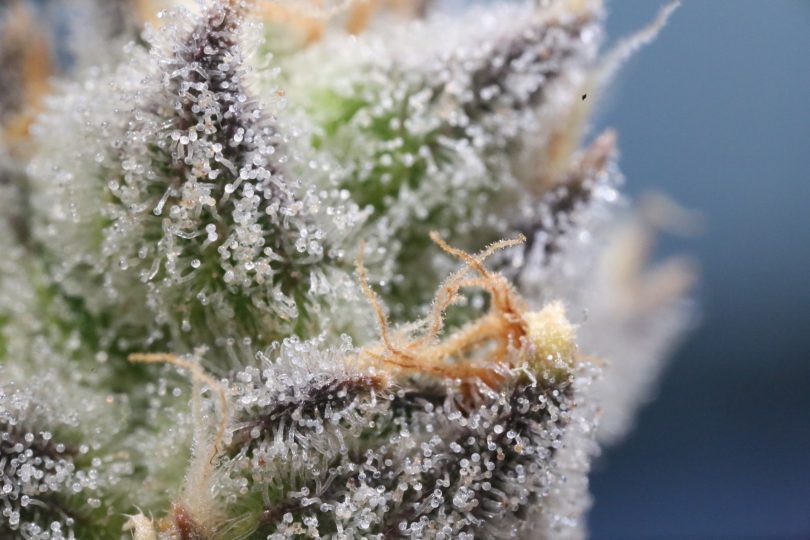Study explores cannabis trichome anatomy, development, & chemistry
Cannabis trichomes serve to defend the plant. Most are familiar with glandular trichomes, which secrete and store cannabinoids, terpenes, and other desired phytochemicals. Medical cannabis is associated with larger trichome gland heads compared to industrial-purposed hemp. [1] Capitate-stalked (stalked) and capitate-sessile (sessile) trichomes are the dominant sources of cannabis phytochemicals. The main physical difference is that sessile trichomes are smaller and lack a stalk. Bulbous trichomes are smaller still with low phytocannabinoid content. [1]
But we already knew that. A recent study by Livingston et al [1] published in The Plant Journal takes this superficial understanding of trichomes to the next level by “characterizing their internal anatomy, biochemistry, and transcriptome.”
Internal Anatomy
The study relied on flowers from female hemp plants (Finola), particularly calyces where trichomes were most dense. Cryo-scanning electronic microscopy (cryoSEM) allowed for structural examination/images without altering metabolism or causing damage. The researchers also developed a “two-photon laser scanning fluorescence microscopy approach.” Fluorescence microscopy means using high-intensity light (in this case, a “red-shifted pulsed laser”) to excite the sample and cause it to subsequently emit low-intensity light based on intrinsic fluorescence. Such emissions result in a 3-dimensional image with color illumination depending on sample properties. Of course, words often fail to do a picture justice. The imagery from the microscopy (especially fluorescence microscopy) is impressive and can be viewed within the free access study (figures 1-4).
The researchers implemented spectral filters for a false-teal channel (420-460 nm) and a false-red channel (495-540 nm). Stalked trichomes had a single large blue-shifted droplet in the bulbous head and several small blue droplets surrounding it. Sessile trichomes, on the other hand, were comprised of many red-shifted droplets. Bulbous trichomes were a combination of a blue cell and a red cavity. The researchers suggest that the blue-shifted fluorescence relates to cannabinoid content since stalked trichomes tend to have higher cannabinoid levels. Importantly, calyx sessile trichomes demonstrated intermediate qualities (e.g., teal:red fluorescence ratio) between vegetative leaf sessile trichomes and calyx stalked trichomes.
These differences held true when the researchers tested tetrahydrocannabinol (THC)-rich cannabis (namely, cultivars Purple Kush and Hindu Kush). The authors declare that “trichomes on mature cannabis organs can be distinguished not only by whether they sit on the epidermis or a stalk, but also by their intrinsic fluorescence and the arrangements of metabolites in their storage cavities.”
Trichome Development
One key research question centered on the hypothesis that sessile trichomes develop into stalked trichomes as cannabis matures. Thus, the authors quantified sessile and stalked trichomes during plant development using a software known as Atlas (Fibics, Inc.). The data demonstrated a positive correlation between calyx length (i.e., development stage) and dominance of stalked trichomes.
Furthermore, staining nuclei with DAPI (4′,6-diamidino-2-phenylindole) revealed that stalked trichomes had more (12-16) secretory disc cells compared to vegetative sessile (8). Yet, the authors found that sessile trichomes on immature calyces often (75%) had greater than 8 cells. This appears to indicate a transition. Based on the researchers’ statistical model predictions (binomial logistic regression), most trichomes (86%) with more than 8 cells become stalked trichomes.
Given the aforementioned differences in secretory disc cells and fluorescence, Livingston et al [1] surmised that “most of the sessile trichomes on immature flowers appear destined to become stalked as the calyx matures…” Such trichomes are labeled “pre-stalked.” [1]
Finally, the study covers chemical and transcriptomic analysis. The findings in this arena were also significant and intriguing—but will have to wait until next week as we dive deeper into trichomes.
Reference
- Livingston SJ, et al. “Cannabis Glandular Trichomes Alter Morphology and Metabolite Content During Flower Maturation.” The Plant Journal, 101, no.1, 2020, doi:10.1111/tpj.14516. Impact Factor: 5.775 Times Cited: 4
Image: Next Green Wave on Unsplash








